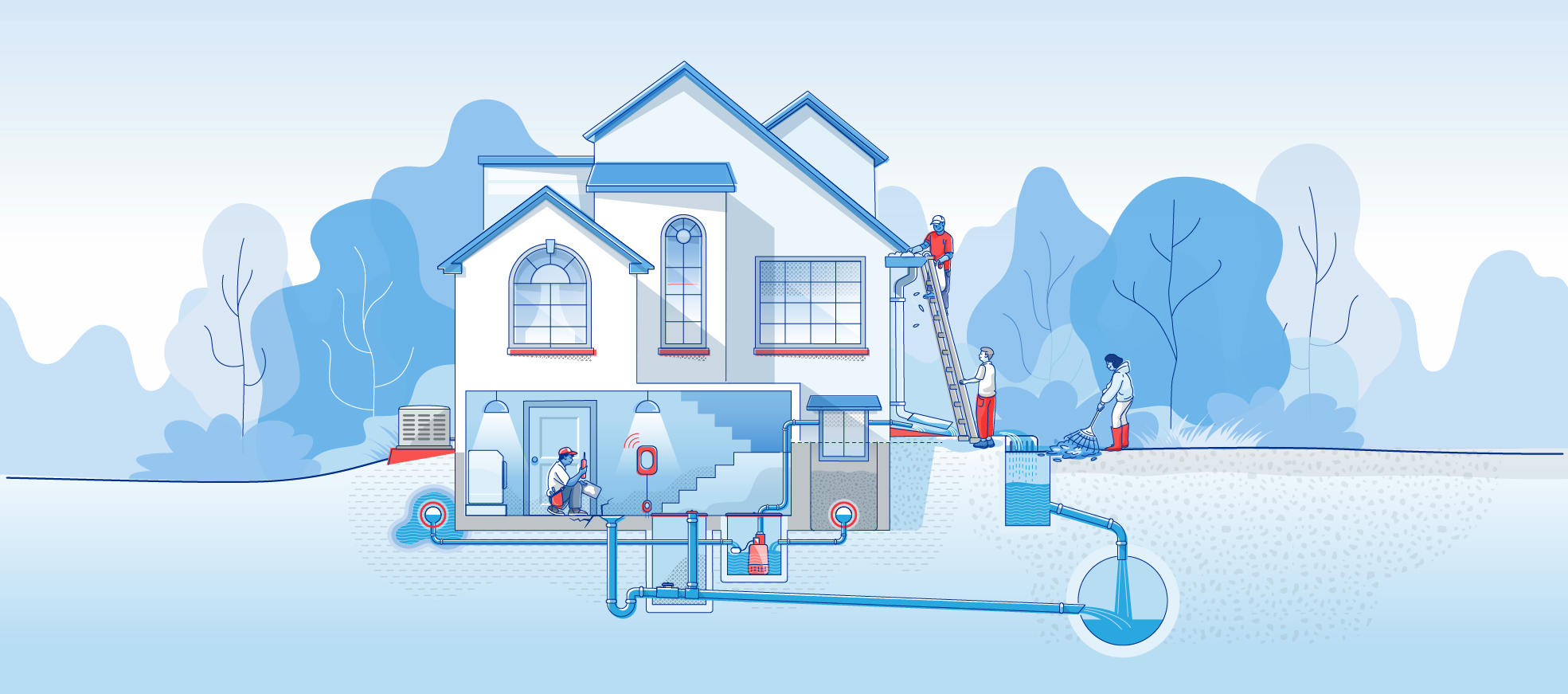All
Protecting Your Home Against Flooding: Preventative Maintenance
January 30, 2025
3 minute read

Flooding can happen in any number of ways. “If it rains near you, you can flood,” states Glenn McGillivray, Managing Director at the Institute for Catastrophic Loss Reduction (ICLR). “Your home doesn’t have to be near a body of water, river, creek or stream to be at risk.” That makes pretty much any home vulnerable since malfunctioning municipal systems, faults in internal plumbing and, of course, overflowing bodies of water can also cause flooding. Basically, when there’s a lot of water in a short period of time due to any kind of event — or a combination of them — you’re at risk because often, systems can’t handle that amount of rain.
When flooding water enters your basement, it can cause major damage that may impact the rest of your home. Thankfully, some easy and regular home maintenance can go a long way in shoring up your home against flooding. Here’s what the ICLR suggests you do.
Seal cracks in your foundation walls and basement floors.
Freezing and thawing temperatures, expanding tree roots, poor soil composition, construction additions and improper grading are just a few of the things that can cause cracks in your foundation. If left unattended, cracks can grow and lead to structural or water issues. Most cracks can be sealed from inside your home, and if you do have to dig, you will likely only need to excavate beside the foundation to repair these.
Check up on your downspouts.
Downspouts help direct water to flow from the eavestroughs on your roof down the side of your house. Ideally, downspouts should be disconnected if they run underground and are connected into your weeping tiles. In some municipalities, connected downspouts may no longer be permitted. After disconnection, check that your downspouts extend at least 1.8 metres away from your home and that the water flows over your garden or lawn—instead of across a solid surface like a walk or driveway where water can’t get reabsorbed and where icing may occur in winter. If your downspouts aren’t long enough, you may need to add an extension.
Does your home grading make the grade?
The grading around your home should direct water away from your foundation and never slope toward the house. Ideally, the ground should be one inch lower for every foot you move away from your foundation. If this isn’t the case, you’ll want to build up and regrade your foundation with solid soil like clay, to allow water from rainfall or floods to flow away from the home.
Heighten protection against low-level basement windows.
Basement windows close to the ground surface create an ideal place for water to pool and then seep into your home. Window wells and well covers can reduce the risk of water entering. Ensure yours fit snugly against the wall and that the bottom of the well is 15 cm below the underside of the window and has a mixture of gravel and sand to allow for drainage.
Have a certified plumber inspect your home to check on the following:
Weeping tile. Weeping tile is a pipe-shaped drain that runs along the bottom of a home’s foundation. If your home is older, it may not have these. In this case, you should consider having them installed. These types of drains can become clogged with silt or dirt or collapse in places. A plumber can tell you if your weeping tiles are experiencing issues. If your weeping tiles need to be replaced, consider getting a cleanout port that can be accessed from the surface for easier maintenance in the future.
Sump pump. A sump pump moves water from under and around your basement to outside your home. When weeping tiles aren’t connected to sewer laterals—the pipes that carry wastewater from your home to street sewers—a sump pump is needed. If the water table under your home is high, you’ll likely need a sump pump. If you already have one and live in a flood-prone area, it’s important to ensure it’s working properly. Learn more about sump pumps here.
Backwater valve. Backwater valves allow sewage to flow in one direction—out of your house. If sewage begins to move back towards your basement, the backwater valve will close, preventing sewer backup. Some municipalities will give you a rebate to cover some of the costs for equipment, labour, permits and tax for having a backwater valve installed. Read more about backwater valves here and check with your municipality for eligibility.
Sewer laterals. These pipes that connect your home’s plumbing system to your city’s sewer system should also be regularly maintained. They can get clogged with fats, oils and grease from your sink drain, which can restrict flow and cause sewer backup. Your plumber can use a camera to check on the condition of your laterals, and, if need be, can access your cleanout port to unclog them.
Following these preventative tips can increase the chances of keeping your basement dry. Since home maintenance isn’t for everyone, consider hiring a licensed and insured professional to do some of these tasks.
This advice is intended to provide general information only and is not intended to provide legal or professional advice, or to be relied on in any dispute, claim, action, demand or proceeding. CAA Insurance Company does not accept liability for any damage or injury resulting from reliance on this information.
